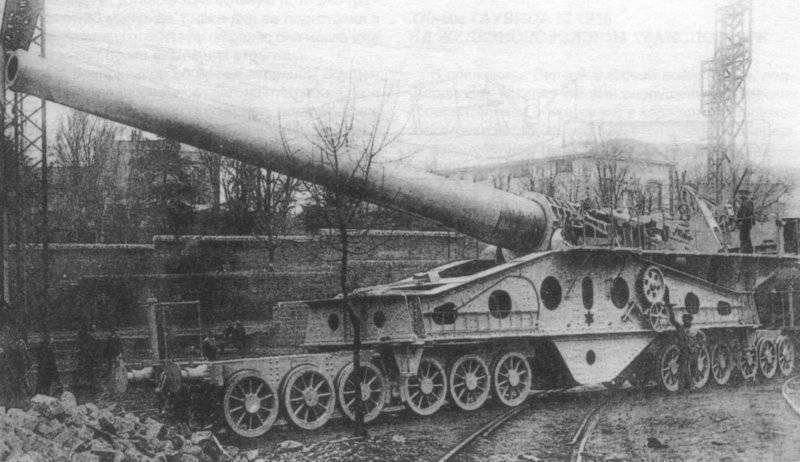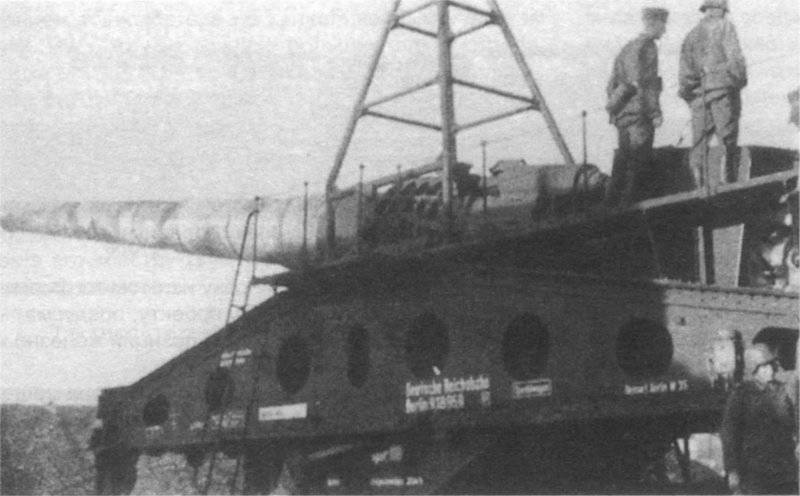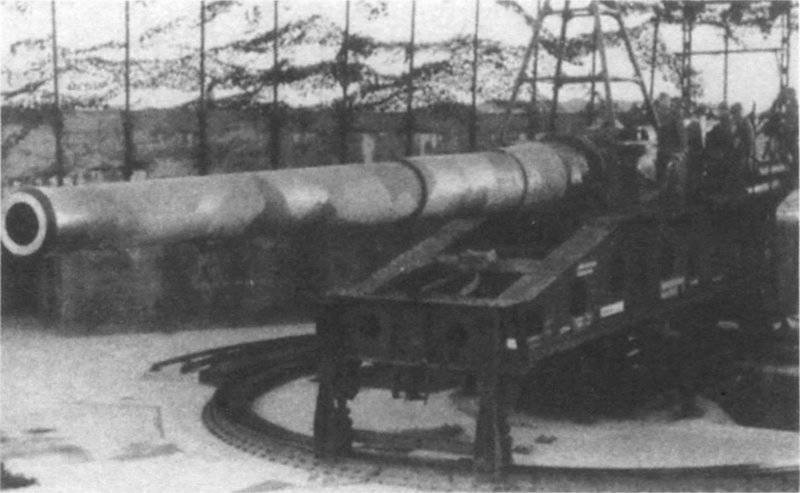The guns on the railway transporter. French 340-mm gun 1912 M on the "carriage with a cradle"
To defeat the enemy's fortifications, a semi-armored projectile weighing 555 kg was used. On the railway transporter, the gun was installed using powerful recoil devices - 4 hydraulic recoil brakes, as well as a pneumatic knurler. The transporter consisted of a main beam, mounted on two railway carts with six axles. The longitudinal supporting structures of the beam had a horizontal lower belt. In the upper part, the profile of these structures had a lift to install the gun in such a way that if there is a specially dug ditch under the breech of the gun, the angle of the vertical guidance of the gun in + 42 degrees was provided.
To prepare the firing position it was necessary not only to prepare the ditch under the breech of the gun, but also to carry out other very labor-intensive preparatory work. First of all, on both sides of the railway track, two narrow railway tracks were created, which serve to move the assembly crane (tonnage of 4). With the help of this crane the central support was prepared - wooden bars were laid in two layers crosswise. This base with the size of 2,5 x 3,0 meter was used for laying two more bars, which are the support for the base plate (made by casting).
Wooden bars were also used to make supports for the rear and front of the main beam. After the installation was supplied to the firing position under it, the rail track was dismantled, the central pin of the machine gun was inserted into the axle of the cast base plate and, with the help of hydraulic jacks, the main beam was lowered onto the central support. After that, the railway carts rolled out from under the main beam and, with the help of screw jacks, were supported on specially prepared supports of the rear and front parts of the main beam. Preparing such a firing position required 4 - 5 days. True, once the settlement, manned by American soldiers, performed all the preparatory work within a day and a half, but to achieve this record they created ideal conditions.
After the installation was supplied to the firing position, 30 was needed - 60 minutes for its preparation for firing. The installation could leave the firing position 25 minutes after the shooting. During the shooting, ammunition was fed from an armored cellar car. With the help of a crane, semi-charges and projectiles were placed at the preparatory post, which was equipped behind the breech of the gun on the main beam, the barrel of the gun was transferred to the declination angle -8 degrees for loading. After that, the projectile and poluzaryadov under the influence of its own mass were fed into the barrel charging chamber along an inclined chute. It should be noted that careful calculation of all elements of the conveyor structure, as well as due to the arrangement of numerous cuts in places of construction that are not subjected to heavy loads, the weight of the artillery installation as a whole was only 166 tons, which is approximately 100 tons less than the weight of installations of a similar caliber developed by other companies .
Several such installations in 1940 were captured by German forces and under the designation 34, see Kanone (E) 674 (f) used on the Atlantic coast of France in the coastal defense system.
Performance characteristics:
Caliber - 340 mm;
Barrel length - 47,4 calibers;
The largest angle of elevation is 42 degrees;
Angle of horizontal fire - 10 degrees;
Weight in traveling position - 166000 kg;
The mass of the high-explosive projectile - 465 kg;
The initial velocity of the projectile - 893 m / s;
The longest firing range - 33000 m.



Information